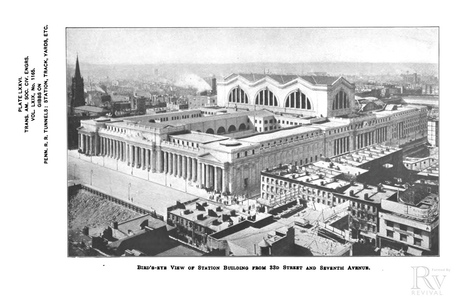 When the walls of Charles Follen McKim's 1910 Penn Station fell to the wrecking ball in 1963, the American public and the International community were outraged at the loss and that New York City "would permit this monumental act of vandalism against one of the largest and finest landmarks of its age of Roman elegance." (New York Times, Oct 30, 1963). That same editorial would go on to say, "we will probably be judged not by the monuments that we build but by those we have destroyed." Powerful words in defense of a truly irreplaceable part of the old fabric of New York City. Since then, the American wrecker has lost the ability to take his pinch bars, wrecking bars, DeArmond bars to just any old building. The narrow Tower Building in New York city was lost very quickly after only living for 25 years to the wreckers and quickly replaced by more offices. Nowadays, if anything "of a significant age" is suddenly in the cross hairs of a developer, more often than not it will come before the city's historical preservation board. In the city of Alameda alone, huge historic Victorian mansions were being razed at a rate of one or two a week and being replaced with large, unattractive apartment monstrosities. In this case, the motive was a mayor who held interests in the contracting company that was doing much of the expansion work. But we need these historical buildings to surround us on a day to day basis. I had spoken with a few Italians on my most recent trip to Florence who said, "I do not understand the American need to count everything as historic for this could have been the place where Abraham Lincoln once stopped to use the toilet." Although, I was ready to defend my country tooth and nail, the Italian man did have a point. At what point was it too much? My hometown of Alameda does pride itself on its remaining Victorians and some older historical looking buildings, but the town is growing and expanding and starting to encroach on new territories. At the western end of the island is the long abandoned Alameda Naval Air station. Famous for being the operational base for the China Clipper and her sisters. There are a few historical buildings as well, but for the most part, stuff left behind from the 1950's and 1960's that very rapidly began falling apart. The entire base takes up a fifth of usable land on the island and there is literally nothing happening there other than adaptive reuse of large buildings for a brewery, distillery and a few other miscellaneous uses. But there is a defensive group trying to save several of the buildings which is great, but in reality might not get a future use. Perhaps the design might save the buildings, turning them into mixed use and transforming the west end into a viable community space. So when you end up with a historical property, you have two directions you can move in. Working to preserve the features, and replicating many of them or you can fight the city tooth and nail to build something new. You'll find the latter an embittering experience as many developers trying to work their way around hard set laws. You'll find people who live in already historic neighborhoods and homes not too keen on having a neighbor with a garage that fronts the street taking up 30% of the front facade. The reason we would even buy a historic home in the first place is to live in the charm of it and maintain the interior finishes we would consider amazingly intricate for modern day standards. The details we find in single built homes is something that modern day tract housing lacks due to cost cutting standards and across the board efficient practices. I remember my parents buying a new home back in 1993 with my mother stating "I want to be able to live in it without having to do any sort of major renovations to it." I cannot express how much money they've spent since saying those words updating the dated cabinetry (15 years!) and adding details which most suburban homes lacked. She could probably have saved herself that pain and nonsense by buying an older home in the first place and the classic lines would still be just as relevant!
2 Comments
Leave a Reply. |
AuthorHere at Biggs Group, we constantly have a lot of projects going on, and design ideas that can take a design to the next level. Here is a sampling of some of what drives us. Archives
August 2015
Categories |
Photos used under Creative Commons from Bob Jenkin, City of Boston Archives, REVIVALthedigest, StartAgain

 RSS Feed
RSS Feed
